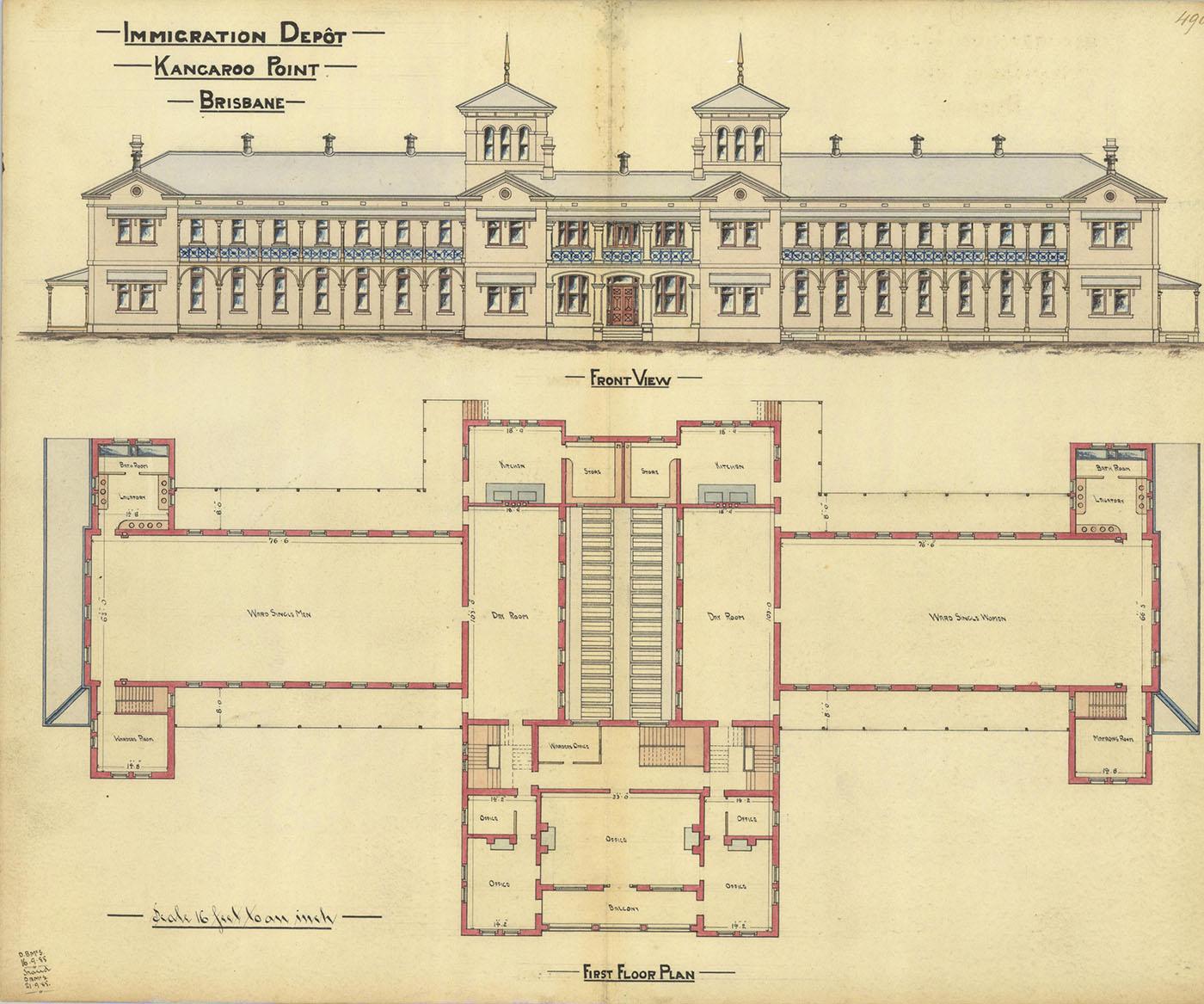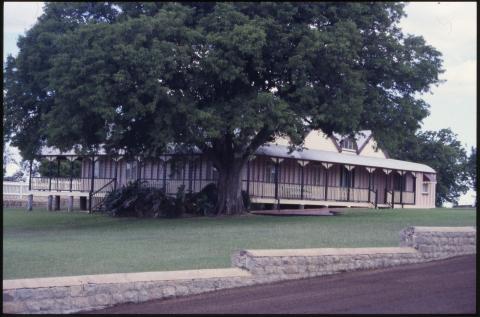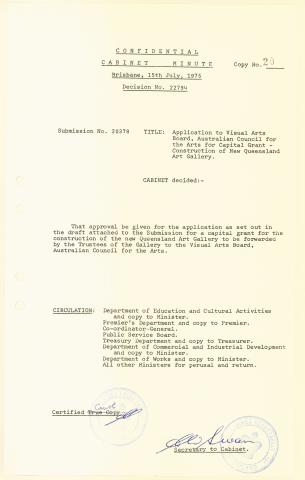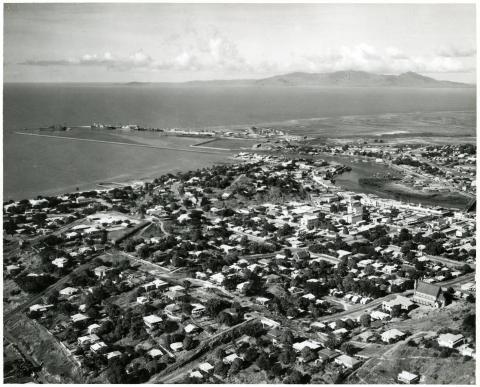
- News of the Day
-
TBA
- Background
-
"Yungaba" is a two-storey brick institutional building designed as an immigrant depot in 1885 by John James Clark, colonial architect for Queensland. Following his dismissal shortly after, the plan was developed by Edward Henry Alder and Robert Henry Mills. Constructed by William Peter Clark, the building is described as being of Italianate/Queensland/ Institutional style.
The government had been aware for some time that the immigration facilities at William Street were inadequate for their needs. The decision to acquire the land at Kangaroo Point was justified by the need to provide 'pleasant surroundings' for those who were recently arrived in the colony. The pattern of immigration fluctuated wildly over the years and the period immediately preceding the construction of the Kangaroo Point depot, immigration had been at an all time high.
The first administrator was William Edward Parry-Okeden. From the outset Parry Okeden saw that a number of critical issues needed to be addressed before the depot could operate efficiently. Problems dogged the project throughout its early years. From the start, difficulties were experienced due to poor drainage resulting from the re-direction of the natural drainage into a stormwater drain. Subsequent drainage works had varying degrees of success but the building soon showed signs of rising damp which was exacerbated by the poor quality bricks used during construction. Gas and water connections were either very basic or completely absent from vital parts of the building, there was no wharf facility at which to disembark the immigrants and, once landed, there was no facility for isolating those suspected of suffering contagious disease.
An outbreak of scarlet fever in 1889 lent urgency to the already noted need for isolation wards in which to treat sick immigrants. The same year a facility was constructed, but, due to an oversight in the plans, it had no facilities for the provision of gas or water or for the disposal of waste and storm water. Similar problems dogged the long awaited 'disinfecting plant' which was first vandalised and later inundated due to faulty drainage.
When immigration levels were low, the building was used for a variety of purposes. In 1900 it served as temporary accommodation for the inmates of the Dunwich Asylum which had been appropriated as an isolation ward for plague victims. In 1904-'06 it was again appropriated as accommodation for South Sea Islanders being repatriated under the new Commonwealth laws. The arrival of an immigrant ship led to the re-location of the Islanders to rented accommodation nearby as it was considered inappropriate to expect the "two races" to co-habit.
The outbreak of World War I led to another change in use, the building being requisitioned for use as a military hospital. Few alterations to the fabric occurred as a consequence, although two single-storey wards were constructed to the southeast of the building. At the end of the war, the building provided an ideal reception area for returning servicemen who, with their wives, were feted at public receptions. Most of the building activity associated with this phase was removed at the end of the war.
From the end of WWI and throughout the '20s, immigration swelled. The Great Depression of the 1930s led to a rapid fall in numbers, exacerbated by the cancellation of the assisted passage schemes. In 1938 the assistance scheme was reinstated and numbers rapidly climbed, only to fall again with the commencement of WWII.
During the period of inactivity in the 1930s, the building was used to house the team working on the construction of the Story Bridge. Accommodation for the superintendent of works, J. J. C. Bradfield, was provided in the eastern room on the ground floor of the north wing. The entire upper floor of the north wing was devoted to offices and drafting rooms for the works in progress. Four dormer windows were inserted into the roof of the North wing dormitory to provide additional light for the draftsmen. The team for the concurrent Stanley River Dam project were relegated to a large room on the lower floor
With the commencement of WWII the hostel was used to accommodate a hundred women and children evacuated from Hong Kong in 1940. In 1941 the depot was once again converted into a hospital, treating general patients. In 1942 it was devoted to 'special' cases - those soldiers suffering the effects of venereal diseases. The buildings along the river frontage continued to be occupied by Evans Deakin, however most of the other structures on the site were used for the treatment of patients. Most of these buildings are now demolished.
The post-war immigration boom led to a renewed life for the building which was now named Yungaba State Immigration Office and Reception Centre. The name "Yungaba" derives from the Gubbi Gubbi Aboriginal language from the Maroochy area and means "place of sunshine". The volume of post-war immigration was such that the hostel was unable to cope with more than a small proportion of new arrivals, and the bulk were re-directed to the many empty military camps around the city. Of these, Camp Columbia at Wacol was perhaps the best known.
In 1988 Yungaba became the first building to entered on the Queensland Estate Register maintained under the Cultural Record (Landscapes Queensland and Queensland Estate) Act 1987. The entry was a result of community concern over the impact of the re-development of Kangaroo Point and the need to conserve significant elements of the community's heritage.
Courtesy of Queensland Heritage Register
/153.0358993,-27.4672448,7/450x450@2x.png?access_token=pk.eyJ1IjoicXNhLWRpc2NvLXFsZCIsImEiOiJjamJmdTgyZXEyeWNjMnlxZm8xcmtieHgxIn0.lmT9J5tTPKGuuccQgCVSAg)



